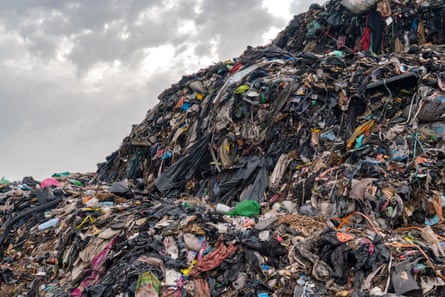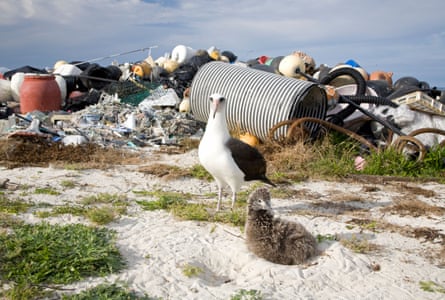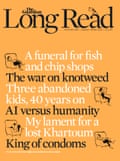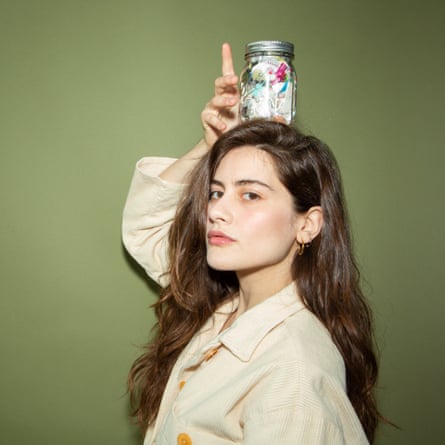One freezing cold morning, I drove past the outer edge of Denver, Colorado, past Buckley air force base, past the suburban neighbourhoods huddled at the edge of the Great Plains. I saw rising from the prairie several low bumps, lifting from the horizon like icebergs. As I got close to them, I saw they were encircled by barbed wire and knew I had reached my destination.
I pulled into the Denver Arapahoe Disposal Site, cutely known as Dads. I was part of a tour, arranged by a local reporter. Ten people gathered around our guide, Doc Nyiro, a Dads manager, middle-aged, with a studious, geeky demeanour. Nyiro began by telling us that Dads is open 24 hours a day, six days a week. Every day, 800 trucks arrive, culminating in about 2m tonnes of refuse a year. We watched the trucks pulling into the weigh station. “It just doesn’t slow down,” Nyiro said. “Truck after truck.”
Climbing into a van, Nyiro took us to an area where a new cell was being constructed: the foundation for a new mountain of trash. It was 10 hectares in size and lined with clay and crushed glass to prevent the liquid that would gather as the rubbish breaks down from leaking into the groundwater. Once completed, the cell will be filled with waste, and would reach 90 metres high within two years.
Next, Nyiro took us to an active landfill area. We joined the line of traffic, driving a steep, rough dirt road to the top of a hill. We watched as a line of trucks stopped around us to empty out everything imaginable. “It looks like they just took all the contents of my apartment and dumped it here,” a man on the tour said, not joking. The wind whipped trash into the air like snow as 100-tonne tractors compressed couches and cookie boxes and everything in between into thick strata that contain the full record of modern life. The result: a dry tomb of waste that will endure for millennia.
Nyiro then led us to a tragically small area of Dads dedicated to gathering recyclable and compostable materials. At the final stop, we visited an electricity plant, with old train motors powered by methane released from decomposing trash. The plant produces enough electricity to power 2,500 homes a year.
By the tour’s end, I couldn’t help but admire the landfill’s efficiency, the engineering that goes into managing so much waste. Dads enables the endless cycle of consumption of my city to go on uninterrupted while reducing the chances of immediate environmental harm. But not every place has the resources to manage such monumental waste. Ghana, for instance, imports around 15m items of secondhand clothing from countries including the UK, US and China every week. Many of these garments end up in informal dumps, which, after seasonal rains, wash out millions of rotting, tangled pieces of clothing on to local beaches.
While grateful for the work of Nyiro and his colleagues, I also felt nauseated. It is hard to stomach seeing what actually comes of our collective consumption – the waste that makes literal mountains, not to mention the waste of resources that are spent on dealing with it. Just this one dump was a perpetual-motion machine to manage a ceaseless flow of abandoned things, like trying to manage the ocean’s tide.
Mass consumption has brought numerous benefits: jobs and financial wealth, physical safety and security. New ways of connecting, talking and thinking. Easy travel to nearly anywhere in the world. Lights that keep the dark nights at bay. Music constantly available.
But the costs have also been staggering. Economic inequality and wars over non-renewable resources have killed untold numbers. The steep increase in products in recent decades has accelerated pollutant emissions, deforestation and climate breakdown. It has depleted water supplies and contributed to the rapid extinction of animals. There are vast “garbage patches” floating across the world’s oceans, with infinite bits of microplastics working their way into food webs. Even if we accept the positives of mass consumption to date, we must acknowledge that the situation is unsustainable. And yet, we can’t seem to stop ourselves.
At the start of 2021, my wife, our daughter and I sat down for a family meeting to see if we could restrain our household’s consumption. I had been drawing inspiration from a range of so-called minimalists and wanted to give it a try. I had investigated the likes of Lauren Singer, who lived a “zero-waste lifestyle” in Brooklyn, limiting her trash of eight years to so few items that they could fit in a single mason jar. I’d read about a family of four in Los Angeles who had given up all plastics. I had learned about Lara Joanna Jarvis, a mother of two in Hampshire, England, who didn’t buy anything for a year and saved £25,000.
“What could we do?” I said, as I opened my laptop and pulled up a Forbes article (ironic for a magazine with a “billionaire’s index”) that provided a guide to a “no buy” year. “How about this?” I asked.
My then nine-year-old daughter nodded in agreement. “I want to save the environment,” she said. She didn’t like all the boxes that things came in. “The environment matters because that’s where animals live and the trees that are living too,” she added. My wife eagerly subscribed to the idea. “And I want to be less consumerist,” she said, “because sometimes you think you have joy out of things. But things don’t bring joy.” We were off to a good start.
There are a wide range of possible motivations for this kind of strategic living: an aesthetic sense (when people like spaces with fewer things), sustainability (driven by concerns over the environment), thrift (saving money), mindfulness (wanting to be more intentional in one’s life) and experience (when people are excited to try different lifestyles). For my daughter, it was the environment; for my wife, mindfulness. For me, I lean toward a minimalist aesthetic. But mainly I was exhausted by endless shopping, and terrified by the possibility that our over-consumption was destroying the planet.
After a moment of silence, my wife reconsidered: “OK, maybe a speaker that brings out music brings out joy.”
She had a point. Living without things is impossible. And things can give us experiences of joy. Things connect us to each other, our pasts, our identities. Even if we loathe some things for the destruction they bring, we love the things that make us who we are. After all, humans have long depended on our things.
“What if,” I improvised, “we don’t do a no-buy year, but a slow-buy year? Besides necessities, we each only get to buy five things this year.”
We considered this. I drafted a list of approved items, not to be counted toward our five things: food, school and work items, health necessities and car parts (if needed). We could accept gifts from others, though we would discourage them. But if we bought gifts to give, then it would count toward our five.
Everyone happily agreed. But after I closed my laptop, I began to think about all the things I wished I had bought before we arrived at this plan – another phone plug, a better automatic cat-feeder, running shoes, sunglasses … maybe this was going to be more difficult than I’d imagined.
My family’s effort was a version of minimalism, a growing movement in many consumerist societies to live with less. There are those who refuse to bring more stuff into their lives. Elizabeth Chai, a 40-year-old in Portland, Oregon, got rid of 2,020 possessions and didn’t buy anything in 2020 except food, drink and toiletries. Others refuse to buy certain things, such as anything made of plastic. Others may give up single-use gadgets or fast fashion or things that just seem wasteful, such as paper plates.

Then there are individuals committed to the ethic of reuse, who throw away less and save items that would otherwise be tossed. In recent years, the app Nextdoor has gained popularity: neighbours use it borrow tools, trade items and give away things headed to landfill. Nextdoor reports that it is used in 11 countries and in nearly one in three US households. Similarly, Buy Nothing – a social network group founded in 2013 and dedicated to the “gift economy” of sharing and loaning items that would otherwise be bought or tossed – has a massively popular app. Creative reuse is also central to Singer and others seeking a “zero-waste lifestyle”, which requires reusing items (such as cloth grocery bags), borrowing others’ items (such as wine glasses from a neighbour for a party), and repurposing or “upcycling” an item (such as turning wine corks into a countertop).
Finally, there are those who reduce, as with my family’s attempt at a slow-buy year. Some have reduced their possessions to just 100 things. The 2021 Netflix documentary The Minimalists: Less Is Now challenges viewers to consider getting rid of one thing in the first month, two things in the second, three things in the third, and so on – selling, giving away or trashing the items. Another version is the rise of a kind of “heirloom materialism”, in which people try to purchase only items that will endure for many years – planned perseverance instead of planned obsolescence. My family’s attempt to slow-buy for a year fell into this last category.
My initial panic endured for a week. I kept coming across things that I “needed” to buy – sunglasses, a bouncy ball to play with my daughter after our favourite one got a hole, a new book, a gift for a friend who had a baby. Let it be said: I resisted all these temptations. I reminded myself to be grateful for what we had, and I found ways to make do. But then the pandemic hit, and suddenly, our small house became my office, gym and vacation spot – the place where our family spent almost every moment of our lives. Hesitantly, we started house-hunting.
By April, we had bought a piano book and a new bike for my daughter. A hole finally opened in the toe of one of my running shoes; I had no choice (I thought) but to buy a new pair. After all, my physical fitness depended on it. My wife bought two books as a gift to a friend.
Then things got dicey. Some permanent pens accidentally went into a load of washing with nearly all my clothes. Still, I resisted buying new ones. But then, the next month, we saw a great house for us. We made an offer, knowing – half-accepting, half-denying – that to make it our home, we would have to buy a lot more than five things each.
When our slow-buy year was on the brink of failure after just six months, I came across a harsh but hilarious screed against minimalism, written by Chelsea Fagan of the Financial Diet blog. Fagan levels multiple arguments against all forms of minimalism. She writes that it is classist, a fad for the rich, because people in real poverty don’t have to worry about what not to buy, and because of how expensive “sustainable” and “heirloom” items often are. “‘Stop wasting money on all that Ikea nonsense!’” Fagan imagined a minimalist saying. “‘With this $4,000 dining table hand-whittled by a failed novelist in Scandinavia, you will never need another piece of furniture!’ – which really just points to having enough disposable income to ‘invest’ in your wardrobe and surroundings.” Furthermore, she derides the idea that a simple aesthetic and decluttering equals moral worth, a “faux spiritualism”. Every form of minimalism, Fagan concludes, “is just another form of conspicuous consumption, a way of saying to the world, ‘Look at me! Look at all of the things I have refused to buy, and the incredibly expensive, sparse items I have deemed worthy instead!’”
Others have pointed out that attacking consumption itself in order to solve the problems of over-consumption is unlikely to succeed. Consumerism has become a symbol of liberty and democratic equality – in today’s world, the idea goes, anyone can consume anything, and thus be turned into the person they want to be. The symbolic glow of consumption cannot simply be turned off.
People do love things. The anthropologist Daniel Miller studied shoppers in London and saw that many people do not see consumption as an act of hedonism, but as necessary provisioning for themselves and their families. The items brought into the household were a way of showing thought and concern about the needs of the people in it. In this way, shopping is a means to express care – an act of love. Anti-consumer logic, in a strange way, can be interpreted as anti-love. And who doesn’t want love?
While these arguments against minimalism – particularly in its most extreme forms – struck me as worryingly true, I also reflected on how much, by at least trying it, I learned about myself, my family’s needs, my relationship with things. When I asked my wife about these critiques, she explained how our slow-buy phase made her pause before each purchase, to ask herself if she really needed the item, or if there was some other way to obtain it. She was less stressed during holidays and birthdays because she knew she didn’t have to worry about what to buy. And it made her consider how, just because a person has the ability to buy something doesn’t mean she should. For her, minimalism isn’t faux spiritualism, but a real contentment and reframing of what brings true joy.
I agreed, even as I worried that while minimalism can be an important approach for individuals, we still need bigger answers – answers that don’t reframe just individual consumption, but how our larger world of consumerism operates.
In the early dawn of one summer day in 2008, Marcus Eriksen’s raft, floating in the Pacific 60 miles west of Los Angeles, was sinking. Fifty-knot gusts churned the sea and threaded through the powerless vessel, pulling it apart. This should not have been a surprise. After all, the raft, named Junk, was constructed of a Cessna airplane fuselage sitting atop ply board and strapped to 15,000 plastic bottles.
Eriksen had been motivated by the plastics crisis eight years earlier, when he had visited Midway Atoll, a speck of flat land at the western edge of the Hawaii archipelago. There lay hundreds of thousands of laysan albatross nests. Led by the biologist Heidi Auman, Eriksen’s visit was focused on the amount of plastic that the birds ingest as food. Albatross parents feed their young the shocking range of plastics that litter the island and its waters – toothbrushes, utensils, wires, cigarette lighters – providing a false sense of satiety. Many of the birds die, of course, and their rotting carcasses burst open to reveal stomachs overstuffed with plastics.
Eriksen is a man of action. He dedicated his life to bringing what he witnessed at Midway Atoll to those who were unaware of how humanity’s love affair with plastic had become a horror show for our oceans. In 2003, he paddled 2,000 miles down the Mississippi in the Bottle Rocket, a raft made of 232 two-litre plastic bottles, to bring attention to the waterway’s pollution. Next, Eriksen wanted to see where all the plastic from North America’s rivers ends up.

He travelled to the Great Pacific garbage patch – a collection of human debris bigger than Peru trapped in a circular ocean current – guided by the man who is credited with discovering it, Capt Charlie Moore. There, Eriksen learned that the patch is less garbage and more a thick soup of fragmented plastics, or as he would write, “a kaleidoscope of microplastics, like sprinkles on cupcakes”. He realised it would be nearly impossible to clean up the tiny fragments infiltrating marine life. In 2014, after 24 expeditions, Eriksen and a team of scientists would be the first to estimate the total weight of plastics in the world’s oceans: around 250,000 tonnes.
The scale of this crisis mocks attempts such as my family’s to reduce the amount of waste – especially plastic – in the world. The US Environmental Protection Agency estimated that Americans threw out nearly 51m tonnes of plastic in 2021, or about 140kg per person. Even if I had somehow managed not to consume and throw away a single ounce of plastic for an entire year, my actions would have reduced the country’s total plastic waste by about a vanishingly tiny amount. When I finally did these calculations, the amount of energy and worry I’d spent on my slow-buy year seemed absurd.
This was the conundrum buzzing in my head when I sat down to interview Marcus Eriksen. He wore dark jeans and a black fleece sweater; with glasses perched atop his salt-and-pepper hair, he had a professorial air. Although ascetics point to the question of individual responsibility for what we consume, Eriksen emphasises that our modern debate has been shaped by narratives created by some of the corporations most responsible for the crisis we find ourselves in.
Eriksen believes the primary responsibility for solving the environmental crisis belongs to businesses and governments. Those who produce materials, and those responsible for overseeing it, can act at the scale necessary for real change. “We’re fooling ourselves if we think that individual actions are going to move the meter,” Anna Cummins, co-founder of the 5 Gyres Institute, a non-profit focusing on reducing plastic pollution, recently told the Los Angeles Times. “Every little bit helps, but public policy and corporations have to change.”
Eriksen believes the overall strategy must involve moving from a “linear economy” to a “circular economy”. This is a shift from a single-use, throwaway economy, as he wrote in 2017, to a model “with end-of-life design, recovery, and remanufacture systems that keep synthetic materials like plastic in a closed loop”. Ideally, synthetic materials are increasingly replaced by less environmentally harmful and less wasteful substitutes. Businesses can develop innovative packaging and delivery systems, such as returnable and reusable boxes.
Governments can pass laws that ban certain materials or products, and moderate planned obsolescence – for example, in the US, proposed right to repair legislation would support far more gadgets being repaired instead of replaced. In 2020, France passed an anti-waste law that compelled makers of smartphones, washing machines, televisions, laptops and lawnmowers to list their products on a “repairability index”, and banned companies destroying unsold items. Kenya, Rwanda, Uganda and Tanzania have all banned single-use plastic bags, and Kenya recently outlawed all single-use plastics, along with glass and silverware, in national parks. Legislation in Chile will ban all single-use food and beverage products by 2025. “There is also the zero-waste city model,” Eriksen said. “We especially see this movement in emerging markets that don’t have space for landfills or funds for incinerators.” This strategy involves creating a workforce built around waste sorting, recycling and composting.
These ideas, while visionary, have received considerable criticism. Some suggest that there is little evidence that industrial societies can make the switch from linear to circular and have the anticipated environmental benefits. From an engineering standpoint, some have suggested that it is impossible to build a truly closed-loop system. In industrial production, there will always be times where new materials must be introduced into the system and waste products must exit it. Materials wear down. Machines leak. Some toxins are too dangerous to be recirculated. Additionally, when one study looked at circular economies – not just the industrial mechanisms to create closed-loop systems – there was a paradoxical increase in overall production.
The reason is that precisely because circular production decreases per-unit production costs, there is an increase in demand for the cheaper stuff, which ultimately increases production and reduces the intended environmental benefits of a circular economy. In other cases, the savings in efficiencies are offset by consumer choices about what to do with those potential savings. For example, in recent years, there have been leaps forward in fuel efficiency in cars, but those savings in fuel have been offset by the increase in car size. The study found that steps can be taken to mitigate this “circular-economy rebound”, but that they are incongruous with the goals of for-profit companies.
Still others argue that the circular-economy idea merely reframes rather than rejects the corporate and capitalist assumptions that got us into this mess in the first place. Instead of challenging the goal of growth, circular economies create a new form of growth that is still in the hands of industrial corporations. The accusation is that the circular economy has become a corporate slogan that depoliticises our environmental crisis by seeing the answer as a technical one to be solved by industry, rather than tackling an unjust economic system that gives power and benefits to a few at the cost of the many.
There are strong moral arguments that we have an obligation to reduce our consumption and its associated waste, because although our individual contributions to the environmental crisis may be infinitesimally small, our small sacrifices – buying less plastic, for example – do add up to meaningful change. Such sacrifices also express our values, which can inspire others around us to do their part.
On the collective level, changes must be structural – new public policies, laws, international treaties, infrastructure, economic programmes, investments. No doubt, the idea of the circular economy has practical limitations and may be usurped by commercial interests. But I find it naive to imagine that the world can simply do away with capitalism and the global economy in time to save our planet. In practice, the circular economy is not one approach but many – a wide array of practices within certain industries, a way of thinking about engineering problems, a set of guidelines and aspirations for governments and corporations. Although this range of approaches in some measure fractures the movement into parts, it also means that we can look to these different experiments to see what works and what doesn’t. This moment of emergency requires immediate action, and for now that must mean collaborating with the companies that make our modern world.
It does not mean acquiescence, however. All of us must do our part to push those in power to create real and meaningful change, even as we must seek to make real and meaningful change in our own lives.
This is an edited extract from Stuff: Humanity’s Epic Journey from Naked Ape to Nonstop Shopper, published by Hurst on 30 November and available at guardianbookshop.com

The best stories take time. The Guardian Long Read magazine compiles the finest longform journalism the Guardian has to offer: from politics to technology, food to cosmology, literature to sex, there is something for everyone. Beautifully bound, this 100-page special edition is available to order from the Guardian bookshop and is on sale at selected WH Smith Travel stores.
Credit: Source link




